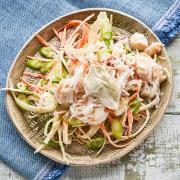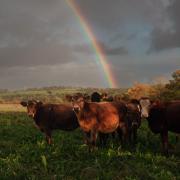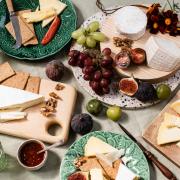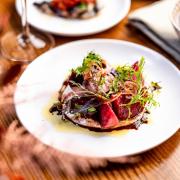Next time you fancy a fish dish, forget the familiar standbys and try something different and local, suggests the author of a new cookbook
For the Love of the Sea II has been hailed as ‘a seafood odyssey’ in the book’s foreword by Rockfish founder Mitch Tonks.
He says: ‘This delightful book not only inspires you with wonderful pictures of our coastline and of fishermen and their communities, but also with recipes from real people, like me and you, that do love British fish and seafood.’
The book reveals stories and recipes from the individuals and businesses that work within the country’s diverse coastal communities, from fishmongers to foragers and basket weavers to marine scientists.

Jenny describes it as ‘a celebration of the small-scale fisherman and woman alongside the hugely important historic crafts, individuals, businesses, and organisations that complement and support them.’
Eating what's in season and local to the region is vitally important to Jenny, as is education about seafood and fishing. She sees sustainability as ‘meeting our own needs without compromising the ability of future generations to meet theirs.’
‘The sustainability of our fish and seafood species highly depends upon not only the region but the season in which they are caught. So, what may be sustainable for you in one part of the country at a certain time of year may not be for others elsewhere.’
Jenny, who spent her childhood holidays in Salcombe and now delights in trying out seafood from the regions, would encourage us to eat a little more adventurously.

‘I always seek out opportunities to try something new at a restaurant that I wouldn’t usually cook or eat at home, staying away from the ‘big five’ most popular species of fish and seafood: prawns, salmon, tuna, cod and haddock. From old favourites such as bass, scallops, mussels, monkfish, and herring to novelties like squid, octopus, clams, and cockles, there is so much more than I can ever imagine.’
The recipes in For the Love of the Sea II combine familiar flavours with fish and seafood in new ways.
Some of the Devon contributors include withy lobster and crab pot maker Susan Morgan and her fisherman husband David from Hope Cove; fishmonger Dan the Fish Man from Clovelly; scallop diver Frazer Pugh and his team at The Handpicked Scallop Company; Offshore Shellfish Ltd which grows mussels in Lyme Bay and Sole of Discretion fishmongers in Plymouth.
For the Love of the Sea II, Meze Publishing, £22.
jennyjefferies.co.uk
Mussel and potato soup

from Sarah Holmyard, head of sales and marketing at Offshore Shellfish Ltd
Enjoy this simple, tasty, seafood winter warmer, which combines mussels, potatoes, onions, milk and cream to make a hearty meal.
Serves 4
Ingredients:
1kg fresh mussels
200g potatoes
2 shallots
2 cloves of garlic
20ml olive oil
Black pepper
400ml milk
50ml single cream
Small bunch of fresh parsley (optional)
Method:
Rinse the mussels and remove the beards, then put in a pan with 2 tablespoons of water. Discard any mussels that do not close when sharply tapped on a hard surface. Cook on a high heat, with the lid on the pan, for 4-5 minutes, until all the shells are open. Drain the mussels, retaining the juice. Leave to cool slightly, then remove the meat from the shells.
Meanwhile, make the mussel juice up to 400ml with water. Dice the potatoes into 2cm cubes, finely dice the shallots and crush the garlic cloves.
Heat the olive oil in a pan and gently sweat the shallots and garlic without browning them. Add the diced potatoes to the pan, followed by your mussel stock. Season the mixture with plenty of black pepper. The mussel juice will be quite salty, so do not add salt until the soup is cooked as it may not be needed.
Bring back to simmering point, then cook for 10 minutes until the potatoes are soft. Using a handheld masher, break up the potatoes slightly to thicken the soup.
Add the mussel meat, milk and cream to the pan and bring the soup back to a simmer. Serve with chopped parsley and crusty bread.
Squid stuffed with herby smoked and white fish

by Sarah Ready of Two Brothers Fishing in Brixham
In this recipe, calamari tubes are stuffed with seasonal, locally sourced white fish and smoked fish, before being cooked just like sausages. The calamari sausages are very versatile and can be eaten on their own, served with a salad or potatoes, or baked in a cheese sauce.
Serves 2 hungry people, or 4 as a light supper
Ingredients:
4 small to medium squid, cleaned
500g white and smoked fish, cooked (a fish pie mixture is good for this recipe)
2 tbsp roughly chopped flat leaf parsley
2 tbsp roughly chopped basil
2 tbsp chopped chives
2 tbsp grated parmesan
1 lemon, zested
1 tbsp extra virgin olive oil
Salt and pepper
Cherry tomatoes (optional)
Method:
Dry the squid and roughly chop the tentacles. For the stuffing, place the cooked fish, chopped herbs, parmesan, lemon zest, tentacles and olive oil in a bowl. Mix until combined, then season to taste.
Stuff the cleaned and dried squid, closing the ends with toothpicks. Chill until ready to cook.
Put a heavy griddle pan on the hob over a high heat. Place the stuffed squid in the pan and cook for around 15 minutes or until slightly brown on the outside, turning as they cook. Be careful not to burn the calamari.
If desired, cherry tomatoes can be added to the pan towards the end of the cooking time. This works well if you’re eating the stuffed squid with potatoes and cooked vegetables. Alternatively, simply serve them with a fresh salad for a lighter summery meal.
Tips: The amount of filling does not have to be an exact science as the result will be the same, as long as the stuffed squid are packed down and left to chill before cooking in a griddle pan.
Bass en papillote

from David Morgan, crab and lobster fisherman from South Devon
This cooking method works wonderfully to produce juicy and aromatic fish dishes, presenting whole fish such as bass, sea bream or mullet in an attractive way using a greaseproof paper or foil envelope. The herbs and other flavourings can easily be adapted to suit your preferences.
Serves 2-3
Ingredients
1 whole bass, gutted and cleaned
Butter or olive oil
Salt and pepper
1-2 onions, sliced
1 fennel bulb, thinly sliced (or you can use sprigs of dill instead)
1 lemon, cut into slices or wedges
Sprigs of fresh thyme
A dry wine
Method:
Note that a 42cm wild-caught bass will feed 2-3 people but farmed fish may be smaller. If you are using red mullet, serve this as individual parcels with one fish per person.
Brush a large piece of greaseproof paper or tin foil generously with the butter or olive oil. Season your cleaned fish with salt and pepper inside and out. Score the sides of larger fish.
Place the fish on the greased paper or foil and fill the cavity with onions, fennel or dill, a couple of lemon slices and some thyme. Add another knob of butter to the cavity with a splash of wine.
Fold the paper or foil over the fish and crimp to seal in all the juices. Place the whole parcel on a baking tray and cook in a preheated oven at 220°c for 10-15 minutes.
Check the parcel after 10 minutes; the fish is ready when it just pulls away from the bone. A large single bass may take 20 minutes.
Serve your bass en papillote with new potatoes and a tomato or green salad.



























